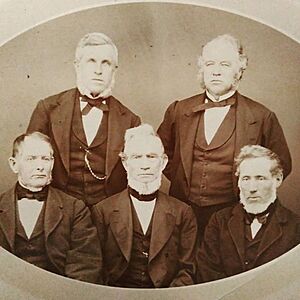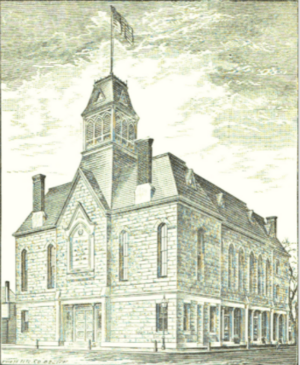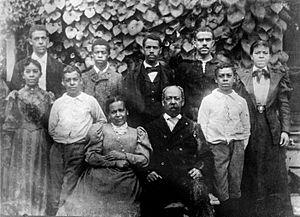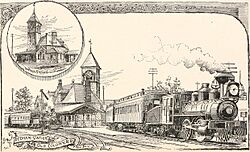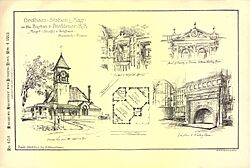History of Dedham, Massachusetts, 1800–1899 facts for kids
The history of Dedham, Massachusetts, from 1800 to 1899 was a time of big changes and lots of growth for the town. Dedham transformed a lot in the early 1800s, perhaps more than it had in its entire past!
Dedham became the main town for the new Norfolk County in 1793, which brought many new people and visitors. New roads (turnpikes) and railroads helped this growth, and inns (taverns) opened to serve travelers. During the 19th century, many old farms became businesses and homes for people who worked in Boston. The town's population more than tripled in this period.
The town government also grew a lot. Dedham got its first public library, a police department, a fire department, and more. New churches were built, and schools like Dedham High School were started. Dedham was also part of some important court cases. The town was known for its "varied and picturesque" scenery and looked "well kept." Several new towns, like Dover, Westwood, and Norwood, were formed from parts of Dedham.
Contents
- How Dedham's Local Government Grew
- Dedham's Role in State and National Government
- Dedham's Military History
- Who Lived in Dedham?
- Interesting People Who Lived in Dedham
- Dedham's Growing Economy
- Places to Stay: Dedham's Taverns
- Special Trees in Dedham
- Dedham's Schools and Education
- New Towns and Neighborhoods from Dedham
- Special Visits and Events
How Dedham's Local Government Grew
The Dedham Public Library opened in 1872. It first rented a space but then built its own beautiful home in 1886. This building, made of local Dedham Granite and red sandstone, opened in 1888 thanks to money left by Hannah Shuttleworth. The Dedham Infirmary, also called the Poor Farm, built a home in 1898.
Dedham got gas streetlights in 1869, and then electric lights in 1890. The Dedham Water Company was started in 1882 to provide water to the town.
The first police officers were hired in 1876. They worked every day from 4 p.m. to 2 a.m. The police department was first located in Memorial Hall.
Fighting Fires: Dedham's Fire Department
In 1800, a group of citizens bought a fire truck made by Paul Revere and gave it to the town. It was called Hero No. 1 and was a big help against fires. Another fire engine, Good Intent No. 2, was bought in 1802, and the Enterprise was added in 1826.
By 1831, the town had bought eight more fire engines! Each engine had its own team of firefighters, and they loved to compete with each other. They often held their yearly meetings and dinners at the Norfolk House.
A firehouse was built in East Dedham in 1846. Later, a new firehouse was built on Bussey Street in 1897. The main fire station was built at the corner of Washington and Bryant Streets. It housed Steamer Number 1, Hose Number 1 (which carried 1,000 feet of hose!), and Hook and Ladder Number 1. These were all pulled by horses.
Town Leaders: Selectmen and Clerks
Here are some of the people who served as Selectmen and Town Clerks:
| Year first elected | Selectman | Total years served |
|---|---|---|
| 1813 | Eliphalet Pond Jr. |
| Year first elected | Town Clerk | Total years served |
|---|---|---|
| 1812 | Josiah Daniell | 3 |
| 1815 | Richard Ellis | 29 |
| 1824 | John Bullard | 1 |
| 1845 | Jonathan H. Cobb | 3 |
| Charles H. Farrington |
Dedham's First Town Hall
After a new courthouse was built in 1827, the old courthouse was sold. Two men thought the town might want to use it as a town hall, so they moved it. But the town decided to build a brand new building in 1828.
However, by 1858, people were complaining that the town hall was too small and not in a good location. It was also considered "too ugly." It couldn't fit many voters, making town meetings crowded and hard to hear.
Memorial Hall: A Special Building
Because the first town hall wasn't good enough, a new building was planned in 1867. This new building would hold town offices and also honor the soldiers who died in the Civil War. The architects designed a very Victorian building, like the town halls in England.
Even though the town had plenty of money for the project, a committee tried to save money by cutting out some parts of the design. This made the building look a bit unfinished from the outside and plain on the inside. Some people called it a "monument" to both the dead soldiers and to "living stupidity" because of the changes.
Brookdale Cemetery: A New Resting Place
For almost 250 years, the Old Village Cemetery was Dedham's only cemetery. But as the town grew, more space was needed. In 1876, a committee was formed to find a new location. In 1877, the town bought over 39 acres of land to create Brookdale Cemetery.
Dedham's Role in State and National Government
In the 1812 election for governor of Massachusetts, Dedham voters supported Democratic-Republican Party candidate Elbridge Gerry. Dedham was a lively place for politics in the 1830s, especially during the time of President Andrew Jackson.
Building a New Courthouse
When the old County Courthouse became outdated, the county leaders decided to build a new one. The old courthouse later became Temperance Hall.
The leaders first wanted a simple, fireproof building to keep important documents safe. But local people wanted a grander building that showed off the town's growing importance. They believed a beautiful "temple of Justice" would inspire respect for the law.
The land for the new courthouse was bought for $1,200. The cornerstone was laid on July 4, 1825, with special ceremonies, bell ringing, and cannon fire. It was designed by Solomon Willard in the Greek style with large pillars. Construction finished in February 1827.
While it looked nice from the outside, it wasn't very comfortable inside. There was only a well for water and no good heating system. One worker complained it was "barren and destitute of every convenience."
In 1854, gas lights and running water were added. In 1860, the building was made fireproof to protect county records. Even though some citizens didn't want big changes to the outside, the building was expanded between 1892 and 1895, adding wings and a large dome.
Dedham's Military History
The Town Cannon's Final Blast
In the mid-1800s, Dedham's old 17th-century cannon was ordered to be destroyed. This cannon was prepared for King Philip's War but never used, and was also ready for the Revolution. A man named Thomas Cobbett, who knew about cannons, took it to a meadow, filled it with gunpowder and gravel, and lit a long fuse. The cannon burst into pieces, and parts were given to residents as souvenirs.
The War of 1812: Dedham's Support
While most of Massachusetts didn't support the War of 1812, Dedham strongly did. Many newspapers called the war "unjustifiable" and "needless," but Dedham's town meeting on July 20 declared it a "just and necessary war." They promised to support it with all their energy.
On August 17, 1812, a meeting was held at Marsh's Tavern to support the war, and the hall was full of supporters despite heavy rain. When news of victory arrived, the old town cannon was brought to the First Church green to celebrate. The minister, Rev. Joshua Bates, tried to stop the firing with a bucket of water, but a captain named Pitt Butterfield insisted the cannon be fired, and it was!
Defending Boston
In June 1814, the British Navy threatened to invade Massachusetts. People on the coast moved their valuables inland. Dedham became a safe place for goods and money from Boston. On September 12, 1814, Dedham's militia marched to Boston to help defend the city.
US Army Troops in Dedham
In 1814, a "regiment of flying artillery" set up headquarters in Dedham to recruit soldiers. Later, in August 1815, another regiment arrived and camped near Mill Creek. Dedham soldiers also fought in the Battle of Lundy's Lane during the War of 1812.
The Powder House: A Winter Adventure
In the mid-1800s, some boys broke into the powder house one winter day. They found barrels of gunpowder and bullets. The boys took the gunpowder to fires where ice skaters were, and the damp powder sizzled when thrown in. They melted down the bullets.
The Civil War: Dedham's Contributions
After the Battle of Fort Sumter, a large meeting was held in Temperance Hall. Forty-seven men immediately signed up to serve, forming Dedham's first military unit since 1846. More men joined, and the first company was formed in early May.
The troops would march through the village streets, with townspeople watching and young boys following along. One time, a recruit opened an umbrella during training, and his captain told him he couldn't march with it. The man left, and later, a dummy of him appeared, causing him to leave town.
The 18th Massachusetts Infantry Regiment, which included 58 men from Dedham, fought in about 15 battles. Many were killed or wounded. When they returned in 1864, Dedham welcomed them with ceremonies.
The 35th Massachusetts Infantry Regiment served for almost three years, fighting in many battles across different states. Of the 68 men from Dedham in this regiment, many were killed or died from disease. They were offered a public welcome home but chose to return quietly to their lives as citizens.
Support from Home
At the start of the war, the women of Dedham immediately began making supplies for the soldiers. In just 24 hours, they sewed 100 flannel shirts! In the next two weeks, they made many more shirts, underwear, towels, and other supplies. Dedham citizens also visited soldiers in camp, and some soldiers got to come home on leave.
After a big battle, news of a defeat reached a church on Sunday morning. The service stopped, and churchgoers immediately organized work parties. Less than six hours later, two wagons full of clothing, bandages, medicines, and other supplies were on their way to Boston to be sent to the troops.
On May 6, 1861, the town voted to support the volunteers and their families during the war. Dedham spent a total of $136,090.81 on equipping troops, supporting families, and giving bonuses to soldiers.
Who Lived in Dedham?
Population Growth
Dedham's population grew a lot in the 19th century, especially with immigrants looking for work in the mills along Mother Brook.
| Historical population | ||||||||||||||||||||||||||||
|---|---|---|---|---|---|---|---|---|---|---|---|---|---|---|---|---|---|---|---|---|---|---|---|---|---|---|---|---|
|
|
|
||||||||||||||||||||||||||
The largest group of new arrivals were the Irish, who came after the Great Famine. Germans also moved to Dedham in large numbers starting in the 1850s. Later in the century, many Italians and Eastern Europeans arrived. Most of these immigrants were Catholic.
Different Backgrounds in Dedham
In the mid-1800s, there were only a few non-white families in Dedham. A student remembered only two Black classmates at the Centre School: Sara Robbins and Sam Johnson. There was also only one Irish student, Patrick "Pat Slat" Slattery.
Neighborhoods often had groups of people from the same country. Germans lived on Shiller Road and Goethe Street. Many Irish families lived on Maverick, Colburn, and Curve streets. An Irish immigrant who lived on Myrtle Street became Superintendent of Streets and later a real estate developer, selling homes to other Irish immigrants.
Interesting People Who Lived in Dedham
Louisa May Alcott's Time in Dedham
Louisa May Alcott's mother, Abba, helped people find jobs. Louisa volunteered to work for James Richardson, helping his frail sister and doing light housework. Louisa thought it would be like a storybook adventure in a grand old house.
However, James Richardson spent more time talking to Louisa than she did with his sister. Louisa got tired of his "philosophical" talks and reminded him she was there to help his sister. He then gave her harder chores, like chopping wood and scrubbing floors.
She quit after seven weeks in 1851. She was so unhappy with the four dollars she was paid that family stories say she mailed the money back to him! Later, she wrote a story about her experience called How I went into service, but a publisher told her she had no future as a writer. Luckily, he was wrong!
The Brown Family's Grand Home
In 1847, a successful merchant named Charles Brown and his wife, Mary Patterson Shaw, moved to Dedham from Boston. They built a very expensive home at the corner of East Street and Auburn Street (now Whiting Avenue). It was one of the most costly homes in the Boston area at the time. After Mary died in 1886, the house was bought by the Boston Children's Friend Society to be a home for boys.
The Gould Family's New Life
After the Civil War, William B. Gould, a Navy veteran who had been enslaved, settled in Dedham with his wife, Cornelia. They raised six sons and two daughters on Milton Street in East Dedham. William Gould became a building contractor and an important person in the community. He did plaster work at St. Mary's Church, helped start the Church of the Good Shepherd, and was very active in the Grand Army of the Republic, a group for Civil War veterans.
When he died in 1923 at age 85, he was buried at Brookdale Cemetery. A statue of him was unveiled on Milton Street in 2023 to honor him.
Horace Mann: A Champion for Education
During the 1800s, Dedham became a summer home for many wealthy Bostonians and a new home for immigrants. One important new resident was Horace Mann. He lived at the Norfolk House and opened a law office in 1823. He quickly became involved in town affairs, often leading town meetings and running for office.
Mann served as Dedham's representative in the state government from 1827 to 1832 and was on the School Committee. In his first year, he gave a speech on Independence Day where he talked about how education, voting wisely, and religious freedom help keep American liberties strong. Former President John Quincy Adams read his speech and had great confidence in Mann's future.
Albert W. Nickerson's Castle
Albert W. Nickerson arrived in Dedham in 1877. He was a successful businessman and built a home near Connecticut Corner. He was active in the community and gave money to charities. He later sold his house and moved away after a disagreement with the town about taxes.
Years later, he bought a huge 600-acre estate on the Charles River called Riverdale. In 1886, he hired famous architect Henry Hobson Richardson to build him a castle on the estate and Frederick Law Olmsted's firm to do the landscaping. The castle has many interesting features, including secret passages and "legendary underground mazes and hallways"! It was built on a rocky hill so that it would appear magically as carriages arrived.
Dedham's Growing Economy
In the early 19th century, Dedham became a transportation center, which helped industries grow. By 1836, Dedham was a busy place for business and manufacturing. Within 50 years of the railroads arriving in 1836, the population almost doubled.
Dedham's Industries
With the arrival of railroads in 1831, Dedham became a good place for factories. By 1837, mills and factories in town were making cotton and woolen goods, leather, boots, shoes, paper, iron castings, chairs, and hats.
A silk factory opened in 1836 but burned down in 1845. Later, the site became a chocolate factory. In 1845, over 500 people worked in Dedham's industries. There were cotton mills, woolen mills, a paper factory, tanneries, woodworking factories, and many smaller businesses making things like boots, shoes, and cigars.
Major Jacob Clark was a building contractor who later became a millwright, setting up water-wheels for mills. His factory was powered by horses walking in a circle. After Clark's death in 1837, his partner and apprentice continued the business, moving their shop and eventually using steam power.
Sumner Wilson had a carpenter shop run by horsepower. Elisha McIntosh had a carriage manufacturing shop on Court Street. Dedham's economy had its ups and downs, like the national economy.
Dedham Pottery: Famous Ceramics
Hugh C. Robertson moved the Dedham Pottery factory from Chelsea to Dedham in 1896. The factory, which usually employed only a few people, was on Pottery Lane. The company closed in 1942, and the building burned down in the 1970s. Maude Davenport, who grew up in Dedham, was known as the company's most skilled decorator.
Roads and Travel
New main roads, called turnpikes, were built through Dedham in the early 1800s, connecting Boston to Providence and Dedham to Hartford. In 1810, a stagecoach left Boston at 4 a.m. and arrived in Hartford at 8 p.m., only stopping to change horses.
In 1802, a new turnpike, the Norfolk and Bristol Turnpike, was planned. It created modern-day Washington Street from Dedham Square to the Roxbury line. Other streets, like Mt. Auburn Street (now Whiting Avenue) and Mt. Vernon Street, were also laid out. Modern-day Worthington Street was known as Wilson's Lane.
The Arrival of Railroads
When railroads first arrived in Dedham, people were scared of them. They were new and seemed dangerous, so not many people rode them at first. But this fear didn't last long! The first train line came in 1836, and by 1842, trains had replaced stagecoaches. The first line connected Dedham Square to the main Boston-Providence line. Later, other lines connected Dedham to Walpole and New York.
In 1886, the railroad built a new bridge over High Street and put a granite plaque there to celebrate the bridge and Dedham's 250th anniversary. The plaque was later moved but has since been returned to Dedham.
In 1881, the Boston and Providence Railroad built a station in Dedham Square using Dedham Granite. In its busiest days, over 60 trains a day ran to it. The station was torn down in 1951, and its stones were used to build an addition to the Dedham Public Library.
Moses Boyd was a popular conductor on the Dedham train line. When he celebrated his 25th wedding anniversary, his passengers gave him gifts of cash totaling $600-$700! The railroad's President and Superintendent also attended and gave him a silver plate.
Connecticut Corner: A Business Hub
In 1800, a group of tinsmiths from Connecticut started a business at the corner of Lowder and High Streets. This area became known as Connecticut Corner. Other businesses, like a dry goods store, also opened there. In 1833, the Russel and Baker furniture company moved to the area but later moved downtown after two big fires.
Dedham's Banks
The Dedham Bank was founded in 1814. Ten months after it opened, it had 66 shareholders from many towns. There was an attempted robbery of the Dedham Bank in 1863 using gunpowder.
By the end of the century, the two main banks were the Dedham National Bank, with over $300,000, and the Dedham Institution for Savings, with over $2,000,000 in deposits.
Shops and Stores
A grocery store stood at the corner of School and Washington Streets, owned by the town's treasurer, Austin Bryant. Other grocery stores, a slaughterhouse, and a shoe store were also in town.
There was a tailor, a dry goods store, and a millinery (hat) store. Erastus Shumway owned a stove and tin shop. Nathaniel Hewins was the town's baker. On Court Street, there was a fish market and restaurant. On Church Street, you could find a dry goods store, a stove store, a hat making shop with baths, a barber shop, and a paint shop.
At the corner of Washington and High Streets, where the police station is today, were buildings owned by Charles Coolidge. These buildings included Coolidge's book and newspaper store and a tailor shop. Memorial Hall was later built on this site.
Medical Care
In 1819, George Dixon built a home with an apothecary (pharmacy) shop. After his death, others took over the shop, including George Marsh, who learned the trade in Boston.
Jesse Wheaton, a doctor, also opened an apothecary shop on High Street. He hired his nephew, Jesse Talbot, and Lemuel Thwing to sell his medicines, like Wheaton's Itch Ointment, around New England and Canada from a large wagon.
Jeremy Stimson was a family doctor and president of the Dedham Bank. Doctor Samuel Stillman Whitney lived in Franklin Square. Another doctor, J.P. Maynard, invented an early version of the Band-Aid.
Farming in Dedham
In 1888, the 97 farms in Dedham produced products worth over $5 million, a big increase from just a few years before.
Other Businesses and Services
In the mid-19th century, Ames Street had a long building with many lawyers' offices. Jeremiah Radford took care of both the Norfolk County Courthouse and St. Paul's Church. Daniel Marsh was a mason.
Dedham's 1889 directory listed 10 blacksmiths, six boarding houses, five hotels, two ice dealers, 17 grocers, seven doctors, four lawyers, 17 dressmakers, and one dentist. The town produced boots, cabinets, chocolate, carriages, cigars, dresses, harnesses, slippers, suspenders, soap, tools, watches, and whips.
Dedham had several newspapers, including the Norfolk Repository, the Dedham Gazette, the Dedham Standard, the Dedham Transcript, and the Norfolk Democrat.
In the 1800s, many Dedham men moved to the Ohio Country because there wasn't enough land in Dedham. This was partly thanks to Manasseh Cutler, a former Dedham resident, who helped convince Congress to approve settlements there.
The town pump, a wooden pump painted green, was located at Franklin Square. It was fed by a spring.
Places to Stay: Dedham's Taverns
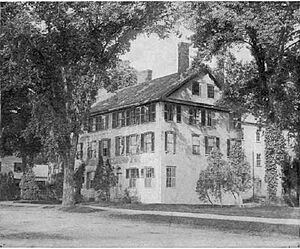
Inns and taverns popped up along the new roads as many stagecoaches passed through Dedham each day. Gay's Tavern could hold over 100 horses, and teams of eight horses could be swapped in just two minutes! Gay's Tavern closed by 1810, and the Ames Tavern closed in 1817.
The Norfolk House
In 1802, a mason named Martin Marsh built his brick home on Court Street, right on one of the new turnpikes. He saw all the traffic and quickly turned his home into a tavern, opening by 1805. His place, the Norfolk House, was very busy because of the new roads and courts.
The Norfolk House was also a center for politics. A young Congressman named Abraham Lincoln gave a speech there on September 20, 1848. He seemed shy at first, but as he spoke, he became very lively and funny. People loved his speech! He stopped exactly when the train bell rang, saying he had to speak in Cambridge. The audience wanted him to continue, but he had to leave.
The Phoenix Hotel: A Social Hub
The Phoenix Hotel was one of Dedham's most popular social spots in the 19th century. It was located at the corner of High Street and Washington Street in Dedham Square. Famous guests like Andrew Jackson and James Monroe stayed there.
When the Norfolk and Bristol Turnpike opened in 1803, Timothy Gay leased a tavern directly on the new road. His stagecoach company meant that all coaches traveling between Providence and Boston stopped at his tavern. The hotel was very busy, with 12 to 15 coaches arriving daily, each carrying many passengers. The stables could hold over 100 horses, and teams of eight horses could be swapped out in just two minutes.
Baseball Rules Were Made Here!
On May 13, 1858, members of different baseball teams from the Boston area met at the Phoenix Hotel. They formed the Massachusetts Association of Baseball Players, which included a team from Dedham.
This group created a set of rules known as the Massachusetts Game. In this game, there were no foul balls, the bases were in a rectangular shape, and games lasted until one team scored 100 runs! After adopting 17 rules, they played a game that many residents came to watch.
Later Years of the Phoenix Hotel
The Phoenix Hotel continued to be a popular place under different owners. John Howe and his wife owned it from 1850 to 1879, making it a leading social spot. During the Civil War, officers from nearby Camp Meigs often visited. Later, it became known as a spa where people from Boston could relax.
Its last owner, Henry White, owned it for only a year before it burned down on Christmas morning, December 25, 1880. It was Dedham's last tavern, and its burning marked the end of Dedham's stagecoach travel days.
Special Trees in Dedham
In 1832, a tree in West Dedham (now Westwood) was named for the fortuneteller Moll Pitcher. She liked to rest under its shade. One hot day, she asked a worker for cider, and when he refused, she broke her pipe and told him his neck would break too. She also said the house he was working on would burn down, which it did years later.
In the mid-1800s, a large sycamore tree stood at the corner of Court and Church Streets. People say this was where lawbreakers were tied and whipped. It was also the location of the town's pillory, a device used for public punishment.
Dedham's Schools and Education
Even though Dedham had the first public school in the country, the state sued the town in 1819 for not having a grammar school teacher.
By 1848, people like Rev. Dr. Alvan Lamson and Horace Mann argued that the school districts should be removed. Mann called the law allowing districts "the most harmful law ever passed" about schools. The districts were finally ended in 1866, and the town bought all 11 school buildings.
By 1890, Dedham had a "complete system of graded schools" in 13 buildings. On January 11, 1895, citizens gathered to celebrate the 250th anniversary of the founding of the nation's first free, tax-supported public school. The governor and other important people gave speeches.
Dedham High School: A Place for Learning
By 1827, Massachusetts required towns with over 500 families to have a free public high school. Starting in 1844, the School Committee kept recommending that Dedham open a high school. It wasn't until 1850, under threat of a lawsuit, that the town voted to open one. They set aside $3,000 to support it.
The new school opened on September 15, 1851, with 42 students. It was located above the Masonic Hall, a space that used to be a private school. The high school stayed there until 1854, then moved to the Town House. In 1855, a new school building was built on Highland Street. A newer school was built on Bryant Street in 1887, and students moved in on October 3.
New Towns and Neighborhoods from Dedham
Dedham has been called the "Mother of Towns" because so many communities were formed from its original land.
| Community | Year incorporated as a town | Notes |
|---|---|---|
| Dover | 1836 | Was a part of Dedham called Springfield. |
| Hyde Park | 1868 | 800 acres were taken from Dedham, plus land from other towns. |
| Norwood | 1872 | Was a precinct of Dedham. |
| Westwood | 1897 | The last community to break away directly from Dedham. |
Dover: A New Town
In 1729, the Springfield area of Dedham became its own precinct, and later, in 1836, it became the town of Dover.
Norwood: Seeking Its Own High School
The southern part of Dedham had often complained about not getting a fair share of town services, especially about their children not being able to attend high school. In 1872, they separated and formed the town of Norwood, Massachusetts.
Westwood: The Last to Leave
In 1897, the third parish became the last area to break away directly from Dedham, forming the town of Westwood.
New Neighborhoods in Dedham
In the 19th century, many old farms in Dedham were turned into businesses and homes for people who worked in Boston.
In 1871, the last part of the Whiting family farm was sold and developed into a neighborhood called Oakdale. By 1895, Oakdale was still mostly woods with only a few houses. Today, Whiting Avenue is home to the High School and Middle School.
In 1867, the Farrington farm became the Endicott neighborhood, and in 1873, the Whiting/Turner land was developed into Ashcroft. Fairbanks Park was developed in 1895.
Special Visits and Events
President James Monroe's Visit
During his tour of the country in 1817, President James Monroe visited Dedham. He stayed at the home of Edward Dowse. Many people escorted him from the Norfolk border to the Boston line, including soldiers. Monroe reviewed the troops on the Town Common and met residents the next morning.
Famous Visitors to Fisher Ames
After he retired from Congress, important Federalist leaders continued to visit Fisher Ames in Dedham. In 1800, Alexander Hamilton visited Ames on his tour of New England. In 1803, Gouverneur Morris also visited Fisher Ames in Dedham.
Local Organizations
The Norfolk House was also where the Society in Dedham for Apprehending Horse Thieves was founded on June 4, 1810. This group is the oldest continuously existing horse thief apprehending organization in the United States! A Masonic lodge also opened in 1803.
Ghosts in the Cemeteries!
When spiritualism (the belief in communicating with the dead) became popular in the 1840s, many people in Dedham became interested.
A few decades later, in October 1877, a "spook" was seen in the Old Village Cemetery. A man named P.H. Hurley was walking through the graveyard when he was approached by the ghost, which then leaped over a tall fence. Later that night, another man saw the spook in Brookdale Cemetery.
The spook seen by Hurley and Ward was described as over seven feet tall and wearing a long blue coat. Others reported seeing a silent, still spectral woman in the cemeteries, pointing at graves.
One report said the spook liked eggs, so the police checked a grocery store. Women in town made sure their husbands were really their husbands before letting them in! A woman in Oakdale even fired a shotgun at the spook.
Around midnight on November 8, neighbors heard shots fired in the cemetery. The caretaker found a red liquid and a handprint on a gravestone, along with trampled grass. The constable thought it was blood, but the Police Chief said it was just red ink and that the "spook sensation" was just pranksters.
Newspapers from Boston and New York covered the story. One reporter even spent the night in the cemetery hoping to see the ghost. By the end of November, when a ghost was seen in another town, the sightings in Dedham stopped.
Celebrating Independence Day
In the early 1800s, residents would gather at taverns for a feast, to drink toasts, read the United States Declaration of Independence, and celebrate the "Glorious Fourth" of July.
By the mid-1800s, a new tradition started: the Parade of Antiques and Horribles. People, both old and young, would dress in funny costumes, making fun of a famous Boston parade.
In the 1880s, young people started climbing to the top of the Church of the Good Shepherd to ring the bell at midnight on July 4th. This tradition later led to wagons being brought to Oakdale Square and set on fire in the early 1900s.
|


